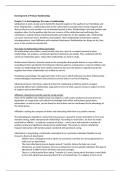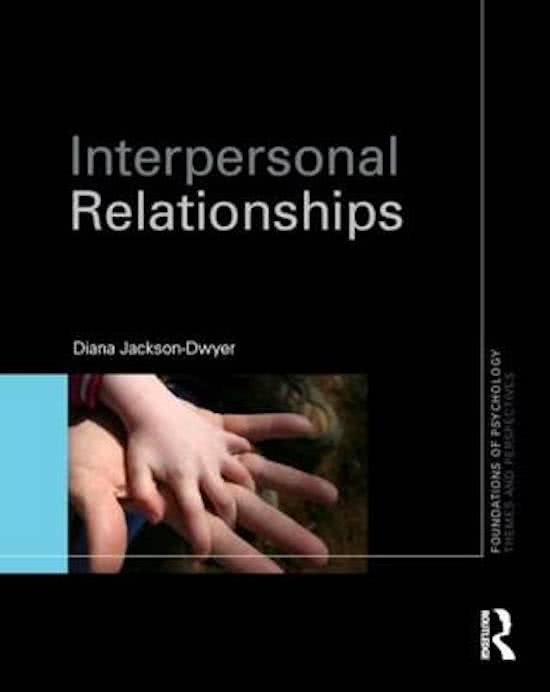Development of Primary Relationships
Chapter 1: In the beginning: the roots of relationships
Satisfaction at work, at play and in family life depends largely on the quality of our friendships and
loves. Relationship: a relationship exists to the extent that two people exert strong, frequent and
diverse effects on one another over an extended period of time. Relationships have both positive and
negatives sides. On the positive side they are a source of life satisfaction and well-being; they
contribute to a good mental and physical health and longevity. On the negative side, relationships
can cause enormous stress, loneliness and isolation. Most relationships include three aspects:
interdependence, need fulfilment and emotional attachment. Relationships are things we do, they
occur in the context of everyday life.
The study of relationships within psychology
All relationships exist within a social context, they are a part of a complex network of other
relationships, not simply an emotional experience between two people. This, combined with the
variety of relationship types, makes that relationships are hard to study.
Reinforcement theories: theories based on the assumption that people behave in ways which are
rewarding to them and desist from behaviour that has adverse consequences. A person initiates and
remains in relationships that have positive outcomes but once the balance is tipped towards the
negative then these relationships are unlikely to survive.
Evolutionary psychology: this approach looks at the way in which behaviour has been influenced by
evolved biological mechanisms that enhances survival and/or survival of offspring.
Attachment theory: this theory states that the first relationship a child has with its caregiver
profoundly affects later relationships, especially in terms of what a person comes to expect in terms
of support and trustworthiness.
Affiliation, attachment and the need for social contact
Many of the abilities that enable humans to adapt to a wide variety of physical environment are
dependent on cooperation and collective knowledge both within and between generations.
Information, as well as tasks, can be shared so that actions can be coordinated to the advantage of
the whole group.
Affiliation: seeking the company of others and interacting with them in a positive manner.
The belongingness hypothesis: states that humans have a powerful, innate motivation to form and
maintain strong, stable interpersonal relationships. According to researchers, we have an innate
need both to affiliate – to seek the company of others – and to form and maintain a number of
positive, lasting and significant interpersonal relationships. This need can only be satisfied by
frequent interaction with familiar people combined with persistent caring.
Attachment: a long-lasting, emotionally meaningful tie to a particular individual. Bowlby has put
forward a theory of attachment:
- Children have a biological need to attach to one person and they are ‘pre-programmed’ to
make such an attachment.
- The main attachment process begins around 7 months, before the baby can crawl.
- Monotropy: an innate tendency to form an attachment to one specific individual. This type of
attachment is different from all others and much stronger.
- There is a critical period from about 7 months to 3 years, during which the baby is most likely
to form this attachment bond and that if it is not formed then, it is unlikely to form at all.
, - First attachment serves as an internal working model, which is the basis of our expectations
and rules regarding relationships in later life.
Some aspects are controversial, Schaffer and Emerson (1964) demonstrated that attachment does
not appear to be monotropic.
There are stages in the development of attachment (Schaffer & Emerson, 1964)
- Universally sociable: by 6 weeks they smile at anyone and don’t care who responds to them.
Once they are able to discriminate among individuals, they begin to show marked
preferences which become more marked over the following months.
- From the second to third months children seem capable of recognizing faces and are more
likely to smile in response to familiar people.
- Around 7 months, the first strong attachment appears. At about the same time, children
become wary of unfamiliar people.
- Once children are mobile, they use the adult as a secure base from which to explore.
- The child starts to form additional attachments with others who he or she sees consistently
and with whom they have a mutually enjoyable time.
The study ‘Strange Situation’ investigates the relationship between the caregiver and young child.
The child’s reactions are observed with particular interest taken in four types of behaviour.
- The response the child makes when the mother departs.
- The child’s willingness to explore and play with the new toys.
- The reaction of the child to the stranger.
- Reunion behaviour, how the child behaves when the mother returns.
Ainsworth concluded that infants have very different types of attachment to their caregiver:
- Secure attachment (type B): infants explore freely when their mother is present and use her
as a secure base. They show distress when she leaves and greet her warmly when she
returns. They are readily comforted by her.
- Resistant (anxious) attachment (type C): children do not explore the new toys with such
confidence. They remain closer to their mother, showing signs of insecurity even in her
presence. They become very distressed when she leaves, when she returns, they asy cling to
her but show ambivalent reactions such as hitting her while still clinging. They are clearly
angry and anxious, and the mother does not provide a secure base.
- Avoidant attachment (type A): children show little or no concern when the mother leaves or
pleasure when she returns. There is no indication of stranger anxiety, and the child shows
little preference for mother over the stranger, avoiding both.
- Disorganized, insecure attachment (type D): children show no set pattern of behaviour when
the mother departs or when she returns (disorganized). This kind of behaviour is associated
with abused children or those whose mothers are chronically depressed.
Children who do not have a warm, intimate and continuous relationship with the mother may suffer
from maternal deprivation, which was said to occur when a child under the age of 3 is deprived of his
or her mother for a period of at least 3 months or has a number of changes of mother figure. Bowlby
believes that the type of attachment a child forms acts as an internal working model for all later
relationships and helps to shape all intimate interpersonal relationships later in life. He also believes
that in some of the most severe cases of deprivation, a child may, as an adult, have an affectionless
personality: an inability to show affection or concern for others or to form long-term meaningful
relationships. Such children or adults are often superficially sociable but have no real concern for
others or capacity to care for people. They fail to develop a conscience or feelings of guilt, and tend
to be persistent liars, thieves or psychopaths. This inability to form deep bonds applies to the way
they feel about their own children, so their own infanta may find bonding difficult or impossible.
, Baby’s adaptiveness: the caregiving system
Virtually from birth human babies have a particular interest in human faces and will stare intently at
them. The presence for face-like patterns may play an important role in the development of
behaviour by focusing attention to stimuli that later have adaptive significance. Faces provide the
richest and most reliable clues to feelings and behavioural intentions.
It is essential for babies to be able to differentiate between familiar people and strangers. As they
become exposed to more and more faces in their everyday lives babies focus on the kinds of faces
they see most often and tune out other types.
By 4 months of age infants smile more at smiling faces. As they get older, the degree of sympathy
they show increases, and they can easily interpret emotions. By 2 months of age infants engage in
complex, highly responsive interactions with their main caregivers. During the first 6 months infants
develop a growing awareness of the characteristics of those people who are part of their social
world. These early interactions lay the foundation for the understanding of self and others.
Infants have impressive prelinguistic skills: as early as the first days of life, newborn babies regulate
their behaviour to synchronize with the pattern of human speech, showing small but consistent
bodily movements in response to the rhythmic sounds of normal speech. Speech in any language
evokes these bodily movements but environmental sounds or nonsense speech do not. Newborns
are particularly responsive to regular patterns of meaningful speech and can differentiate between
random noise or vocalizations and genuine social signs.
Infants possess specific innate behavioural patterns and characteristics that elicit caregiving
behaviour in adults that encourage relationship formation.
Affiliation
Fundamental to the formation of relationships is the tendency to affiliate – that is, to associate or
interact with other people. Hill suggests that are four main motives for affiliation:
- To obtain positive stimulation: people inherently enjoy the company of others, the desire
increases if the people and/or situation are interesting and fun.
- To obtain emotional support and anxiety reduction: when we are in uncertain, ambiguous or
confusing circumstances we tend to seek the company of others in order to obtain guidance
as to how to respond.
- To gain social comparison information: there are certain situations in which we want to
compare ourselves with others and affiliation provides the means of doing this. The social
comparison theory states that people want to compare their own feelings and reactions with
those of others in the same situation.
- To gain attention from other people: there are occasions in which we seek of the company of
others in order to get attention, praise or approval.
Situational factors in affiliation
Our need to affiliate fluctuates across situations; there are times when we want to be with others
and times when we would prefer to be alone. People are particularly keen to be with others under
pleasant conditions and under threatening ones. We prefer to be alone under certain unpleasant
situations, such as when we’re nervous, tense and under circumstances that require concentration.
Personal factors in affiliation
Because people want to affiliate, they have unbuilt behaviour patterns that encourage others to
affiliate with them, they use ‘nonverbal immediacy behaviours’. People who are high in need of
affiliation, use more immediacy behaviours and tend to be popular.






